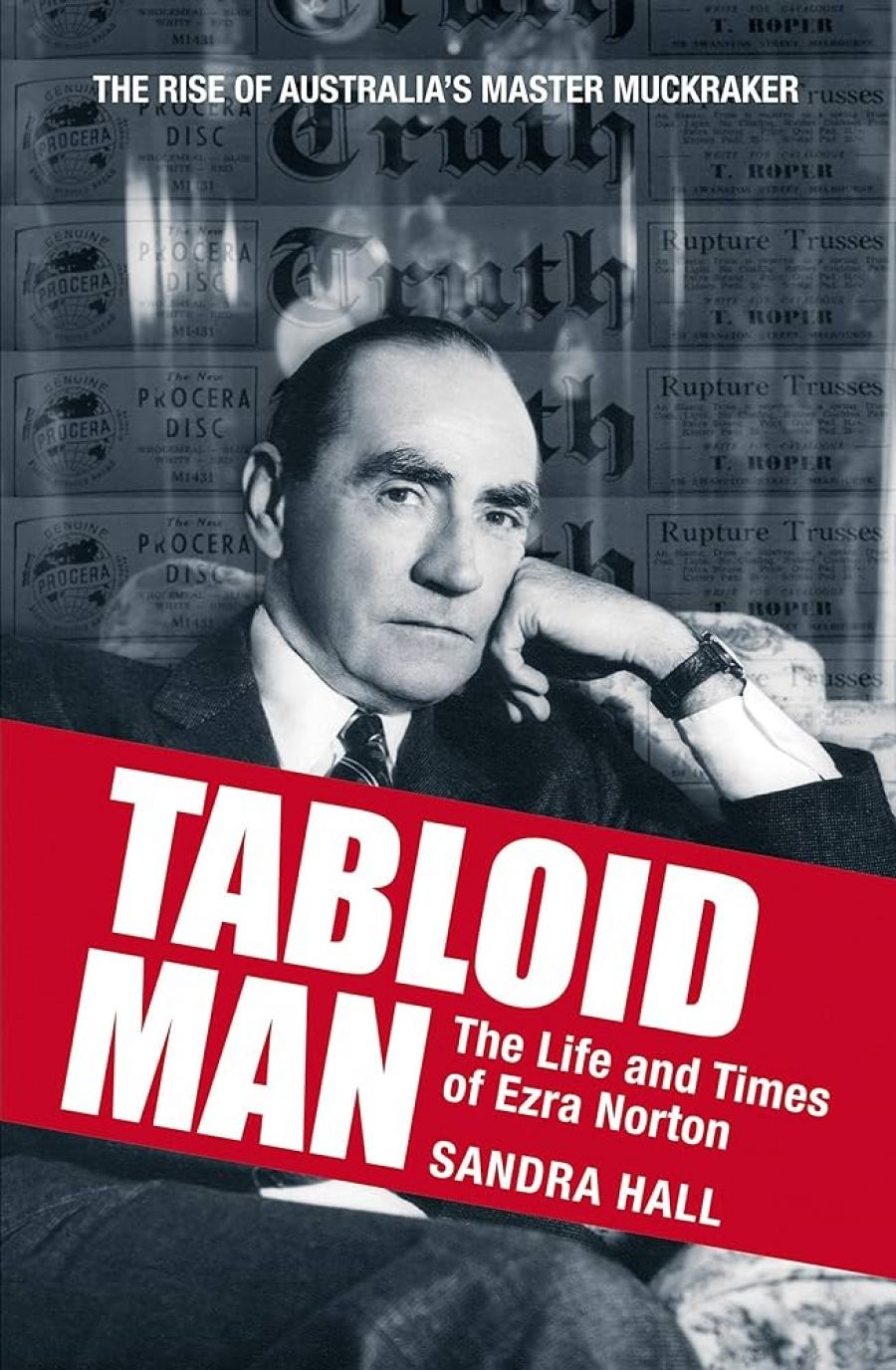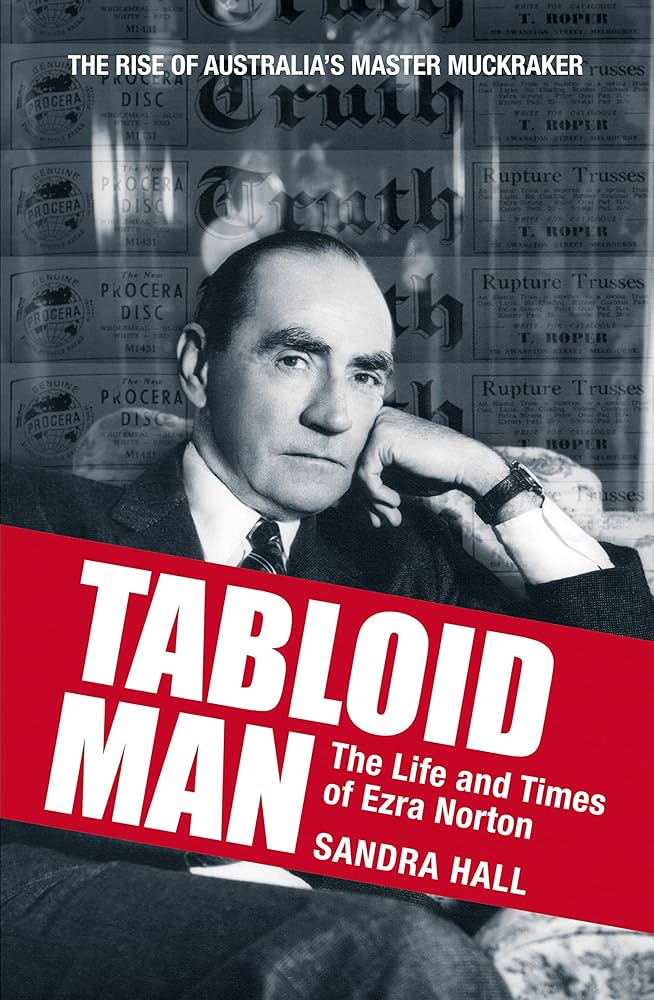
- Free Article: No
- Contents Category: Biography
- Review Article: Yes
- Article Title: Crooks, cronks and crawthumpers
- Online Only: No
- Custom Highlight Text:
Phillip Knightley, Murray Sayle and other authors of the Daily Mirror’s historical feature used to relish their days sitting in the Sydney ‘public library’ researching and writing pieces on rape, pillage, sexual betrayal and murder most foul. Decades later, in the early 1990s, I began spending days sitting in what had become the State Library of New South Wales wading through yellowing copies of Sydney’s tabloid press. On one such day in the late 1990s, I stumbled across a card in a catalogue for an index to the Daily Mirror’s muckraking stablemate, Truth. The discovery or creation of a new newspaper index is always a thrill for media historians. I immediately submitted a call slip for the index, and up came a hefty ledger of alphabetical references to Truth for the late 1920s. Lodging more call slips, I ended up surrounded by ledgers ranging from 1925 to 1947. They were all handwritten, and presumably laboriously compiled by a librarian at Ezra Norton’s company, Truth & Sportsman Ltd. Who knows what went through the librarian’s mind as he or she indexed stories of divorce, rape, incest, prostitution, white slavery and cocaine rackets covered by one of Australia’s most notorious newspapers.
- Book 1 Title: Tabloid Man
- Book 1 Subtitle: The life and times of Ezra Norton
- Book 1 Biblio: Fourth Estate, $35 pb, 335 pp
- Book 1 Cover Small (400 x 600):

- Book 1 Cover (800 x 1200):

As I was researching a biography of Norton’s nemesis, Frank Packer, I went straight to ‘P’. I was not disappointed and found reports of charges for negligent driving; a jewellery heist from the Packer mansion; Gretel Packer tossing her engagement ring from a car window; and a customs breach involving the importation of toys for their sons, Clyde and Kerry. A magistrate was even quoted deploring the ‘gangster tactics’ of the two rival press proprietors. If it hadn’t been for the index, most of these colourful and illuminating incidents might have escaped my attention. The Truth index has now been microfilmed to protect the original, and sits demurely in the Mitchell Library reading room.
It is probably fair to say that, until recently, popular and populist newspapers have attracted less scholarly attention than their more serious counterparts. Scholars have tended to be drawn towards ‘newspapers of record’ and their electronic counterpart, the Australian Broadcasting Corporation. (Sometimes I have wondered whether the fact that the Sydney Morning Herald has a widely available index has helped to account for the volume of its citations.)
It is gratifying to see Sandra Hall – journalist, film critic, novelist and author of a much earlier, and still valuable, book on the Australian media, Supertoy: 20 Years of Australian Television (1976) – turn her attention to Ezra Norton (1897–1967) and his father, John (1858–1916). Hall grew up in a 1950s Sydney household dominated by tabloid newspapers and commercial radio. Interestingly, Harper-Collins (of which Fourth Estate is an imprint) has cornered the media baron publishing market with biographies of Packer (2000), Keith Murdoch (2003) and now the Nortons.
Tabloid Man is a book about the ‘life and times’ of John and Ezra Norton. From Sussex to Sydney, Australian politics to the Sydney sensationalist press, John Norton – self-educated, fluent in French, alcoholic, obsessed with Napoleon – is brought vividly to life. His explosive relationship with his wife, Ada, and the unhappiness of the home in which Ezra and his sister, Joan, were raised, are illuminated by the most scarifying of divorce proceedings, and by reports in Truth itself. Court records have proved a valuable resource for Hall, as Norton Snr and Jr found the libel cases in which their newspapers were involved hugely entertaining and, indeed, part of the papers’ sales appeal. This technique was not confined to Sydney; Truth spread interstate and to New Zealand, where in 1909 John delivered an eleven-hour address to a jury.
No journalistic quickie, Tabloid Man, written over several years, is a thoughtful, carefully researched book. This could not have been anything but a challenge to write, with the zealously private Ezra burning his father’s correspondence, and leaving no diaries and few speeches of his own. It must be said that Ezra does not emerge as sharply as his father. Indeed, even Ezra’s own employee, the irrepressible Eric Baume, emerges somewhat more clearly. This is probably due to a lack of sources. For John Norton, some manuscript recollections, and voluminous court documents, have survived, together with Cyril Pearl’s Wild Men of Sydney (1959), a book so damning that it inspired controversial changes to the New South Wales Defamation Act (1958). There is rather less original private material concerning Ezra, disinherited by his father and invariably described over the years as ‘enigmatic’. Curiously, the fullest discussion of Ezra’s private life and marriage appears towards the end of Tabloid Man, and there is very little on his political dabblings. Hall could have gone back to the wonderful weekly correspondence between the Establishment newspaper figures Keith Murdoch and Lloyd Dumas, instead of just referring to its use in secondary sources.
Hall’s biography vividly evokes the Sydney of the late nineteenth to the mid twentieth century. The Sunday Truth, with its gamey mix of crime, divorce, sex, sport and xenophobia, and its abhorrence of wowserism and political rascality, and the afternoon Daily Mirror, with its lust for sensation, distaste for the unorthodox and forthright appeal to the battlers, appear almost as another set of characters to complement the Nortons. Unfortunately, though, a fifth character is all but absent: the Sportsman, which John Norton had established in 1900, with the injunction to the editor to expose ‘crooks, cronks, and crawthumpers’.
Other newspapers and personalities littering the media landscape are judiciously appraised. Tabloid Man is an engagingly written page-turner. Hall has a deft turn of phrase, referring to Truth’s ‘old difficulty in distinguishing pathos from bathos’, and to the Sun’s chief police reporter, Noel Bailey, as ‘the roly-poly embodiment of Australian nonchalance’.
Very occasionally, the book could benefit from more context. The stance of the Daily Mirror – which, as Hall does note, could ‘never be accused of moving ahead of public opinion’ – on modern art could have been compared with that of Packer’s more progressive Daily Telegraph. Martyn Lyons and Lucy Taksa’s Australian Readers Remember (1992) might have been a useful source. There is also the odd unsourced remark; I was intrigued by the claim that Packer invested in Truth & Sportsman.
There are a few inconsistencies. Jack Gallery, who defects to Consolidated Press on page 184, re-emerges as managing director of Truth & Sportsman on page 268. The Sydney Observer and the London Observer are confused in the text and in the index. The relationship between Associated Newspapers and Associated Press is not made clear. The National Library of Australia is referred to as the Australian National Library, the National Archives of Australia as the Australian Archives.
Overall, however, this is a fine and valuable book. Tabloid Man is also timely given contemporary debates about the paparazzi, celebrity and privacy; the ubiquity of multi-platform media personalities along the lines of Eric Baume; and the retirement of Steve Dunleavy, the Australian-born, most legendary ‘tabloid man’ of recent decades.


Comments powered by CComment